
French postcard by A.N., Paris, no. 1256. Photo: Raymond Voinquel.
French postcard by Editions P.I., Paris, no. 112. Photo: Roger Carlet.

French postcard by A.N., Paris, no. 1263. Photo: Roger Carlet.
French postcard, no. 9. Photo: Gaumont.

French postcard by Editions et Publications Cinématographiques (EPC), no. 300. Photo: Discina.

French postcard by Yvon for Marie France. Photo: Majestic Films / Sirius. Georges Marchal and Dany Robin in Le plus joli péché du monde/The Prettiest Sin in the World (Gilles Grangier, 1951). Caption: Georges Marchal and Dany Robin, the youngest "ideal couple" in French cinema, are more seductive than ever in the new film"Le plus joli péché du monde, The Prettiest Sin in the World. At the backside: Designate the best-suited couple in French cinema.
The typical jeune premier
Georges Marchal was born as Georges Louis Lucot in Nancy, France, in 1920. His family moved to Paris, where he attended secondary school. As an adolescent, he dreamed of becoming a dancer and took classes in ballet and acrobatics. After a chance meeting with Maurice Escande, he changed his mind and aspired to become an actor. First came many odd jobs, like courier, docker at the Les Halles market, and assistant at the Medrano circus. Then he enrolled in an acting course and was hired at the Théâtre du Palais-Royal for the play 'Permission de détente'(Permission to Relax) by Yves Mirande. At 20, he joined the Comédie-Française to play in the classic dramas 'Iphigénie' (Iphigenia) by Jean Racine and 'Psyché' (Psyche) by Molière. He soon also played in boulevard comedies.
His film career started with the comedy Fausse alerte/The French Way (Jacques de Baroncelli, Bernard Dalban, 1940) starring Josephine Baker, which was only released in 1945. During the Occupation days, he was noted in Lumière d'été/Summer Light (Jean Grémillon, 1943) opposite Madeleine Renaud, and Vautrin/Vautrin The Thief (Pierre Billon, 1943) with Michel Simon.
After the war, he co-starred in Au grand balcon/The Grand Terrace (Henri Decoin, 1949) with Pierre Fresnay, about the heroic pilots who struggled, suffered, and often died to carry the mail. He became the typical Jeune Premier of the French post-war cinema and posed as a rival of Jean Marais, although he didn’t reach the same level.
In 1951, he assumed the title role in Il naufrago del Pacifico/Robinson Crusoe (Jeff Musso, 1951), and for Sacha Guitry, he played the young Louis XIV in the star-studded Si Versailles m'était conté/Affairs of Versailles (Sacha Guitry, 1953). In 1951, he married actress Dany Robin. Both were young, beautiful, and adored. They preserved their privacy in their house in Montfort-l'Amaury. Together they made six films, including La voyageuse inattendue/The Unexpected Voyager (Jean Stelli, 1950), based on an old script by Billy Wilder, and the comedy Jupiter (Gilles Grangier, 1952).
Georges’ talent as a stuntman did wonders for his parts in such costume films and Swashbucklers as Messalina/The Affairs of Messalina (Carmine Gallone, 1952) with Maria Félix, Teodora, imperatrice di Bisanzio/Theodora, Slave Empress (Riccardo Freda, 1954) with Gianna Maria Canale, and Les trois mousquetaires/The Three Musketeers (André Hunebelle, 1953) in which he featured as D'Artagnan.
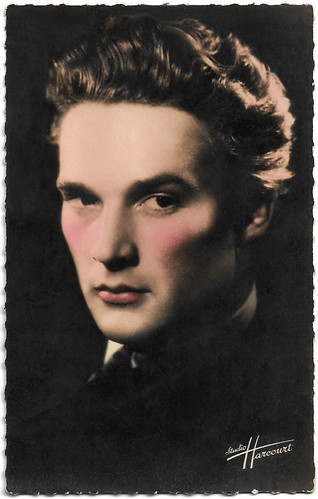
French postcard by Editions O.P., Paris, no. 44. Photo: Studio Harcourt, Paris.
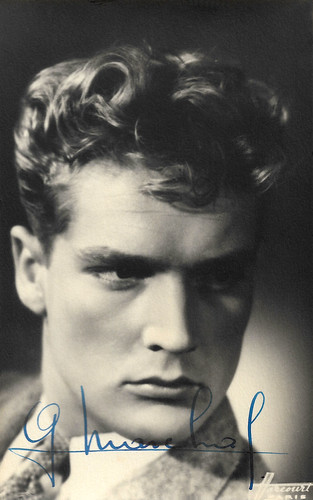
French postcard by Agfa. Photo: Studio Harcourt.

Vintage photo by Harcourt, Paris. French staging of the play 'Iphigénie en Tauride', based on Goethe, directed by Jean Yonnel and performed by the actors of the Comédie française in 1942. Georges Marchal as Pylades and unknown actress.

Vintage photo by Harcourt, Paris. French staging of the stage play Iphigénie en Tauride, based on Goethe, directed by Jean Yonnel and performed by the actors of the Comédie française in 1942. Here, Georges Marchal as Pylades and possibly Maurice Donneaud as Orestes.
French photo. Photo: Studio Harcourt, Paris.
French postcard by S.E.R.P., Paris, no. 219. Photo: Studio Harcourt.
French postcard by Editions du Globe, Paris, no. 175. Photo: Studio Harcourt.
French postcard by Editions du Globe, Paris, no. 185. Photo: Studio Harcourt.
Death knell
The arrival of the Nouvelle Vague (the New Wave of young French directors in the late 1950s) with their animosity against the Cinéma de Papa (the popular French cinema of the 1940s and 1950s) seemed a death knell for Georges Marchal. He moved to Italy, where he continued his career. With his muscular body, he was an ideal hero for the Peplum. He appeared in a dozen of these Italian Sword and Sandal epics, including Nel Segno Di Roma/Sheba and the Gladiator (Guido Brignone - and uncredited Riccardo Freda and Michelangelo Antonioni, 1958) with Anita Ekberg, Le legioni di Cleopatra/Legions of the Nile (Vittorio Cottafavi, 1959) with Linda Cristal, and Sergio Leone's first solo directorial effort, Il colosso di Rodi/The Colossus of Rhodes (Sergio Leone, 1961) with Rory Calhoun.
Marchal was a close friend of director Luis Buñuel and also one of his preferred actors. Marchal starred in four of his films: Cela s'appelle l'aurore/That is the Dawn (1955) with Lucia Bosé, La mort en ce jardin/Death in the Garden (1956) with Simone Signoret, Belle de jour/Beauty of the Day (1967) with Catherine Deneuve, and La voie lactee/The Milky Way (1969) with Laurent Terzieff.
Other interesting films in which he appeared were the anthology film Guerre secrète/The Dirty Game (Terence Young, Christian Jaque, Carlo Lizzani, Werner Klinger, 1965) with Robert Ryan, the Romanian historical epic Dacii/The Dacians (Sergiu Nicolaescu, 1967) with Pierre Brice, Faustine et le bel été/Faustine and the Beautiful Summer (Nina Companeez, 1972) and Les enfants du placard/The Closet Children (Benoît Jacquot, 1977) with Lou Castel.
During the 1970s, he focused on television and appeared in Quentin Durward (Gilles Grangier, 1971), as Philip IV the Fair in Les rois maudits/The Accursed Kings (Claude Barma, 1972), Gaston Phébus (Bernard Borderie, 1977), and Les grandes familles/The Great Families (Edouard Molinaro, 1988) with Michel Piccoli.
He played a seductive older man in three TV films based on the legendary Claudine novels by Colette, Claudine à Paris/Claudine in Paris (1978), Claudine en ménage/Pauline Engaged (1978) and Claudine s'en va/Claudine Goes (1978), all starring Marie-Hélène Breillat and directed by Edouard Molinaro. He also played Claude Jade's father in the fine mini-series L'Île aux trente cercueils/The Island of Thirty Coffins (Marcel Cravenne, 1979). He retired in 1989. His last film appearance had been as General Keller in L'Honneur d'un capitaine/A Captain’s Honour (Pierre Schoendoerffer, 1982) about the French army's behaviour in Algeria. Georges Marchal died in 1997 in Maurens, France, following a long illness. He was married to Dany Robin from 1951 till their much-publicised divorce in 1969. He remarried in 1983 to Michele Heyberger.
French postcard, no. 27. Photo: Industrie Photographique.

French postcard.

French postcard by Editions O.P., Paris, no. 59. Photo: Carlet Ainé.
French postcard by Editions P.I., Paris, no. 172. Photo: Studio Carlet Ainé.
French postcard by Editions P.I., Paris, no. 375. Photo: Sam Lévin.
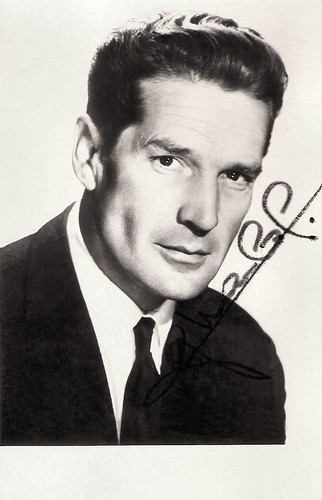
French postcard by P.I., Paris, no. S-1653. Photo: Sam Lévin.
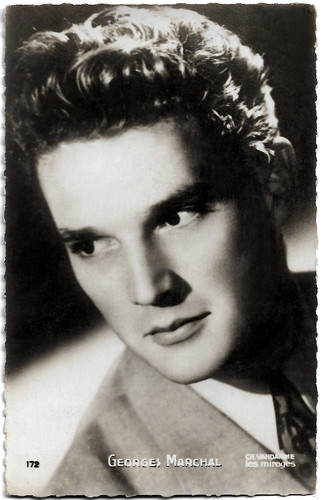
French postcard by Editions P.I., Paris, no. 172. Photo: Charles Vandamme, Les Mirages.
French postcard by Editions P.I., Paris, no. 523 presented by Les Carbones Korès. Photo: Ch. Vandamme.
French postcard by Editions du Globe, Paris, no. 297. Photo: Charles VanDamme, Paris.
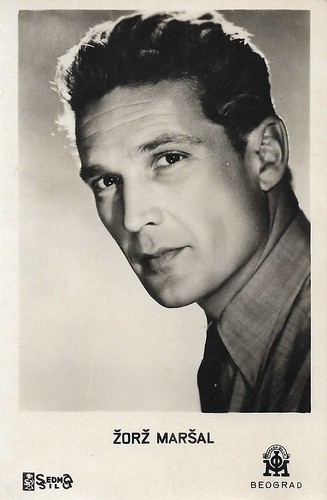
Yugoslav postcard by Sedma Sila. Photo: Morava Film, Beograd (Belgrade).

Cover page of the film programme by Illustrierte Film-Bühne, no. 627. Micheline Presle and Georges Marchal in Les derniers jours de Pompéi (Marcel L'Herbier, Paolo Moffa, 1950).
Swashbuckling in Les trois mousquetaires/The Three Musketeers (1953). Source: Henk de Vos (YouTube).
Sources: Hal Erickson (AllMovie), Pablo Montoya (IMDb), Ciné-Ressources (French), Wikipedia (French), and IMDb.
This post was last updated on 6 May 2025.
I adore the old swashbuckler movies. I'm so glad you included this wonderful actor! I had never heard of him before and I thoroughly enjoyed the movie shorts.
ReplyDeleteThank you and a Happy PFF to you!
Oh my. He is absolutely beeeeyootiful!
ReplyDeleteVery handsome!
ReplyDeleteNo so impressed with the postcard, but great beefcake in the Peplum clip.
ReplyDeleteMarchal looks better in the movie than on the postcard!
ReplyDeletewhat a fantastic film clip of the volcano and the dramatic escape! I always spend more time here, looking through your archive. At first glance I took Marchal for Cocteau's famous Beast, thanks for the in-depth explanation about his rival Marais.
ReplyDelete